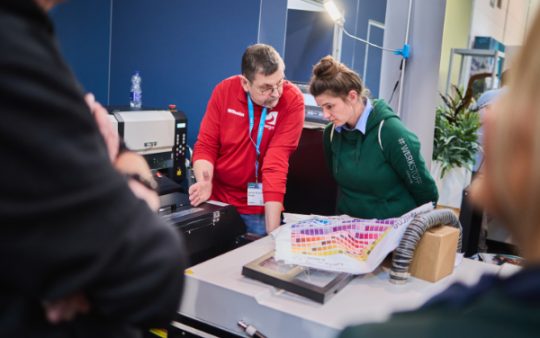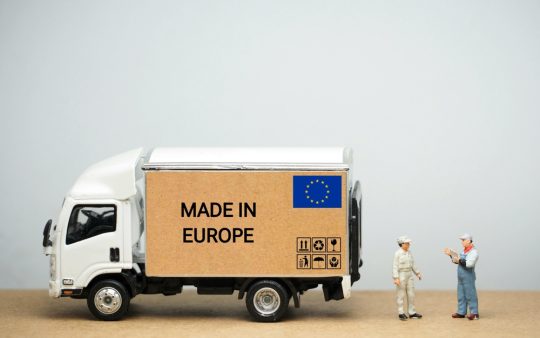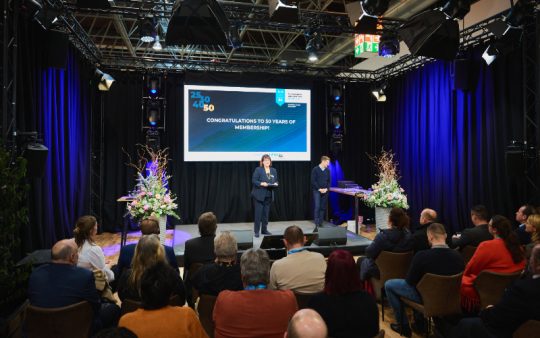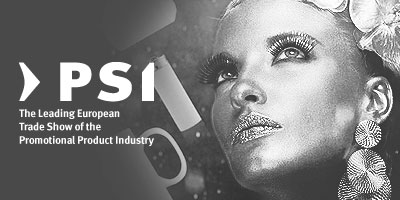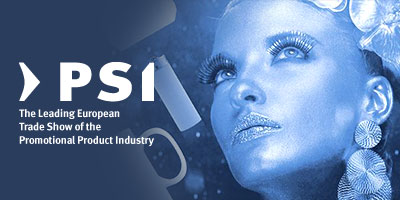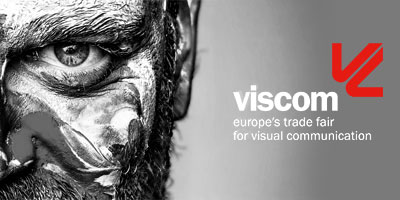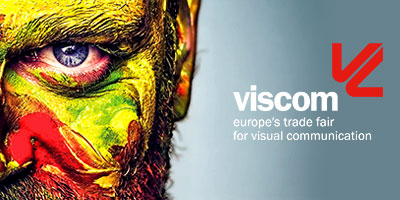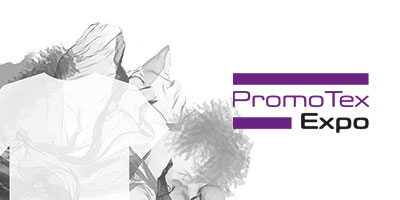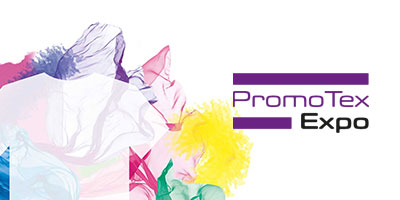Sustainable approaches in textile printing

Published on 14.05.2020
Digital textile printing already offers very versatile design options today and developments in printers and inks are making constant progress. On the occasion of viscom in January 2020 Joachim Rees, Managing Director at Multi-Plot company from Bad Emstal, Germany shared with us how modern printing technologies can also positively impact the sustainability balance of printing.
As a member of the board for digital textile printing in the industrial association – Industrial Textiles – Roller Shutters – Shading ITRS his exhibits centred on new development and technologies at the trade show. Centre stage was fire protection and high-quality digital prints on glass fibre with an A2 fire protection certificate issued for both the material and ink complete with a matching aluminium frame with lighting.
Sublimation printer with fluorescent inks
Novel products, however, were also launched in cooperation with leading manufacturers. Epson presented a new sublimation printer with fluorescent inks for the first time. Especially in sports applications and for occupational health and safety high-vis neon colours play a prominent role. The proven HeatJet 70 evo was used as a calender to make the textile print wash-fast. The sublimation inks used by Epson score points with a special property – an Ecotex certificate Level1 – meaning they are suitable for baby wear. Additionally, Joe Rees presented Sublifusion, the wash-fast and breathing sublimation printing on organic cotton. Presented for the first time at the trade show in January were digitally printed socks by Multiplot. This surprising innovation also enthused the exhibitors and visitors of PSI, the promotional products trade show held in parallel.
Disruptive technology: digital textile printing is gaining in importance
Prints are everywhere, both on fashion items and sportswear, on home textiles and, of course, also on promotional products. However, only 7 to 10% are digitally printed so far. The lion’s share is still accounted for by classic screen printing or rotary printing – but the share of digital textile printing is growing inexorably. Technology is subject to disruptive change. Short delivery times and short runs are changing the textile supply chain and making local business models possible. From an ecological and business perspective pigment printing is beneficial. Nearly all types of wovens can be printed. The textile pigment inks require no coating of cotton for producing a wash-fast, soft and brilliant print result. Pigments are fused without steam and the use of water in the calender. Pigment printing accounts for 50% of classic textile printing and therefore offers an attractive new market for digital printing. The growth prospects for local production are particularly promising in these currently difficult Corona times.
Production runs are getting shorter, more personalised and sustainable
There is a trend towards personalisation today and this applies to all applications for textile printing across various sectors of industry. This means production runs are getting shorter but more personalised instead while at the same time printing should be as sustainable as possible. This is precisely where digital textile printing kicks in. A disadvantage of conventional textile printing technologies is the high consumption of water and chemicals. Digital pigment printing, in contrast to this, can completely forego washing and steaming. In this way up to 1,700 l of water can be saved per dyeing process for 100 kg textiles. The pigment inks used here are (still) more expensive than conventional printing inks but the new technology requires a substantially smaller amount of ink.
Only the amount of fabric is printed that is actually needed. The time-consuming and costly production and subsequent storing of printing templates is rendered superfluous and it is therefore also a lot easier to introduce changes to the print to print designs after the first trial prints. These printing inks are environment-friendly since they are water-based and they do not produce any ink residues that have to be disposed of. Printing widths of up to five metres are possible and the printing quality is as high as 2800 dpi depending on the material composition. Even second-hand textile printing presses can be easily refitted for the new pigment ink, for example presses with Epson or Ricoh printing heads.
Every year about 17% more textiles form digital printing
All of this contributes to an up to 17% annual rise of digitally printed textiles in Europe alone. Another benefit of the new generation of digital printing presses is the possibility to print on ready-made garments. It is already possible today to apply all-over prints to not only socks but also gloves. This flexibility permits a growing number of companies to take to a more local textile finishing. This simplifies logistics and helps to shorten transport distances thereby also contributing to sustainability.
More creative scope thanks to digitality
Especially in design terms digital pigment printing opens up a new dimension. Designer have more scope to respond to customers‘ individual wishes and to finish collections in governable quantities in line with latest trends while still taking sustainable aspects into a account. Even small series can be printed without enormous costs involved in setting up and sampling – thereby leaving plenty of scope for creativity.
At present, Multi-Plot has worked out a number of solutions for face coverings. Face masks are turning into everyday products and therefore also becoming design and fashion items. Design, shapes and materials can be turned into custom products in micro factories fast and in an automated way.
About Multi-Plot
For more than 25 years Multi-Plot has been synonymous with a portfolio of renowned suppliers, competent consulting, high-quality products for digital textile printing and a well-equipped technical service. Through memberships in associations, cooperation with universities and institutes as well as by taking part in important industry events and trade fairs, the company remains at the forefront of all important new developments.
For more information go to www.multiplot.de
Photos: Multi-Plot (see caption)
Copy: Reiner Knochel


